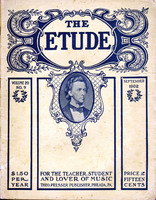The principal varieties of tone-connection in singing may be classified as follows: Legato, Portamento, Marcato, and Staccato. The term Legato is from the Italian legare, to bind, and indicates a tone-connection where the pitch of one tone begins directly at the close of the previous tone without any break of continuity or the introduction of any intervening pitch whatever. This style of tone-connection is understood when there are no qualifying marks indicating otherwise. In the hands of the consummate artist, however, this rule is subordinate to the taste and judgment of the performer, as will be seen later on.
Marcato.
The term Marcato (literally, marked) is used when the composer wishes to give each tone an individual character which they do not possess when executed in the plain legato. There may be the same continuity of tone as in legato, but a mild accent with a slight diminuendo at the end of each, sometimes expressed thus >, individualizes and emphasizes the tones in a manner different from legato. This method of tone-connection is generally accompanied by a ritardando, or moderately slow tempo. When used rapidly the accent is less marked, and it becomes a little more distinct articulation of the vowel. Under these circumstances the proper designating term is leggiero. The marcato is also sometimes indicated by the combination of dots and slur. In general, it may be said to give character and emphasis to the phrase containing it.
Stentato is a kind of exaggerated marcato, while Martellato (literally, hammered or pounded) is used more especially in the repetition of a single tone when extreme force is desired. It is more congenial to the high notes of the female voice.
Portamento.
The Portamento (portare, to carry) is the most important and difficult means of expression so far as relates to tone-connection. Mr. William Shakespeare told the present writer that it expressed love; but who will have the temerity to thus circumscribe the action of this king of expressive means, whose range covers the whole gamut of human feeling, from the most heartfelt expression of love and tenderness to the terrible wailings of sorrow, rage, and despair? It is safe to say that the standing of an artist is measured to a greater extent by the use of the portamento than by almost any other means of expression. It is, of course, impossible to describe the portamento by means of the written word, but it may be roughly sketched in this wise: As is well known, the keys on the piano are separated by the smallest interval of a half tone. Now, if one will endeavor to subdivide this interval into innumerable smaller intervals, welding them together in such a way that the division line is lost or concealed in the process, either ascending or descending, he will have a tolerably fair conception of the portamento. One essential is that it shall reach its climax, or highest or lowest pitch, ahead of time; that is, that the pitch of the final tone shall be attained more or less before the actual place of the tone in notation. Just what shall be the length of this anticipation of the final tone is, of course, a matter of taste. About one-third the length of the first tone is ordinarily a good division. Following out our rule of expression in dynamics, the portamento from a lower to a higher pitch will be accompanied by a crescendo, from a higher to a lower by a diminuendo. There are many exceptions to this rule, however.
From what has been said it will be seen that the delivery of an artistic portamento demands, above everything else, a perfect breath-control. The throat must be held loose and free to effect the delicate changes of pitch which are necessary, and the laryngeal muscles must continually adapt themselves to the changes of breath-pressure which are necessary. The face must express the feeling desired; in fact, the whole nervous system must be responsive to the idea of the composer. There is no especial sign used to indicate the portamento outside of the word itself, and it is just as well that this is so. The employment of such a delicate as well as forceful means of expression should be left to the taste and judgment of the artist or teacher. To the beginner it should be interdicted altogether; even the artist should never make it without due thought and deliberation. Two consecutive portamentos are in bad taste; one should guard against this, especially in the rendition of closing cadences.
Staccato.
The Staccato is a manner of tone-connection which has fallen more or less into disuse contemporary with the decline of the florid Italian aria. As a means of voice-culture it will always be en vogue—as Shakespeare says, “after a million starts on ah” etc. In singing the staccato one should always use the soft attack, in order to avoid throat-strain, holding the breath gently and easily between tones.—Henry W. Giles.



